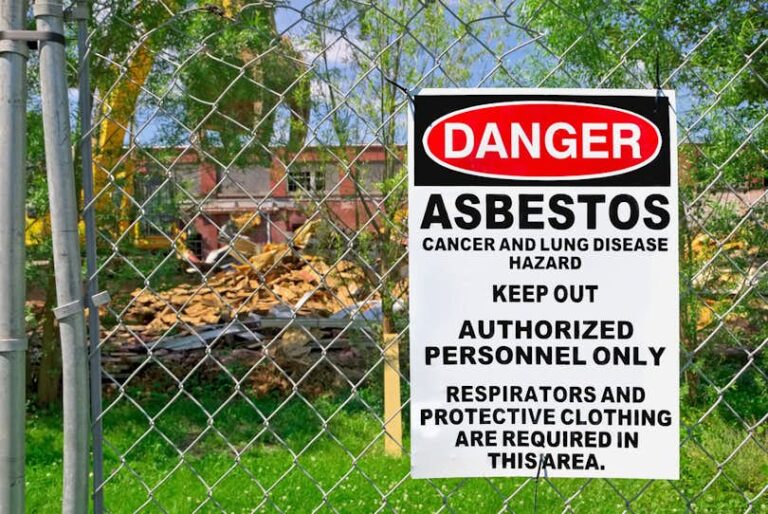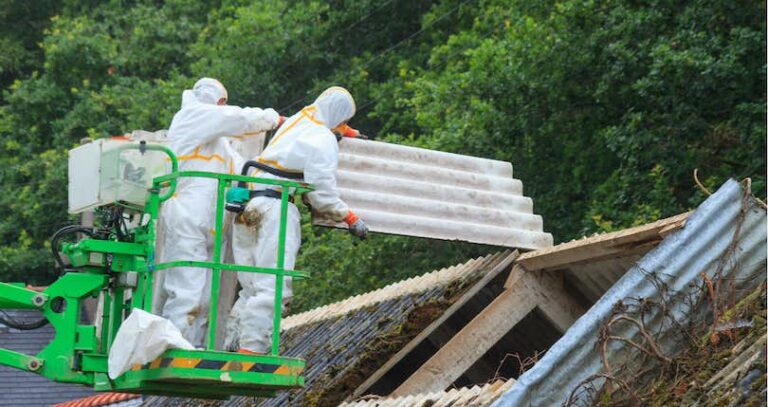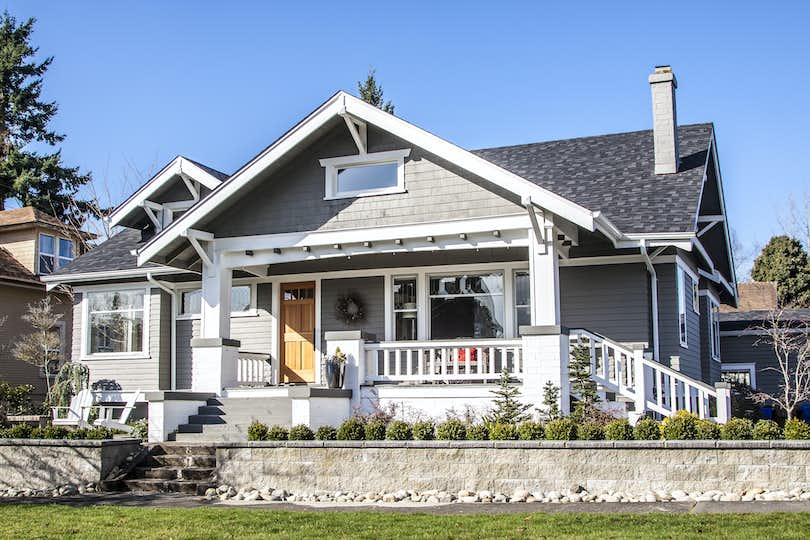
What is asbestos siding | Pros and cons of asbestos siding | What does it look like? | Is asbestos siding safe? | How common is it? | How to tell it’s asbestos | Does it need to be removed? | Repair options and costs | What about resale value? | Can you remove it yourself? | Should you buy? | FAQs
Note: When you work with one of our partners, we may earn a small commission. Learn more about our editorial policy and how we make money.
Buying a house with asbestos siding is largely a matter of personal choice. The decision usually comes down to a buyer's peace of mind knowing both the risks of asbestos and how to them.
Given the well-documented health concerns surrounding asbestos, many home buyers recoil at the thought of asbestos being anywhere near their home.
However, asbestos siding is a common feature in older homes and quite safe when kept in good condition or handled properly during repair and removal.
🔑 Key takeaways
- Asbestos cement was a popular siding on homes built during the mid-1900s.
- When left alone and intact, asbestos siding poses no threat to human health.
- Aging asbestos siding will eventually need to be repaired, covered, or replaced — costing anywhere from a few hundred to several thousand dollars.
- While sellers are required to disclose known asbestos to a prospective buyer, they aren’t legally obligated to fix it — if you want it removed prior to move-in, you’ll need to address the issue during negotiations.
- As a buyer, you could be in for a deal. Some sellers assume buyers won’t want to pay full price for a home with asbestos and adjust their asking price accordingly.
Asbestos siding is known for its extreme durability (it can remain in great condition for several decades) and resistance to fire, pests, and weather damage. That’s why it was such a popular building material in the first place.
Issues arise when asbestos siding is damaged during demolition, renovation, or removal — or begins to dry out and crack with age. When this happens, asbestos mineral fibers can be released into the air and inhaled, increasing the risk of potentially serious health consequences.
| 🤔 Where might you find asbestos in a home? In homes built prior to 1990, asbestos may be found in and around: | |
|
|
As a homeowner, you have several options for dealing with asbestos siding (even on a budget). You can encapsulate it with a sealant or cover it with another siding material.
Both options provide safe and cost-effective alternatives to removal, which the Consumer Product Safety Commission[1] recommends using as a last resort, since it carries the highest risk of releasing fibers into the environment.
If your renovation plans require asbestos removal, your best bet is to have it taken care of by a state-certified asbestos abatement contractor.
» MORE: Find trusted local asbestos contractors
What is asbestos siding?
Asbestos siding was a popular building material used in the construction of homes from the early 1900s through the 1980s.
Manufacturers made it by adding asbestos — a naturally occurring mineral fiber — to Portland cement, a common construction material used as a base for concrete, mortar, grout, and stucco.
Most often, asbestos-containing cement was pressed into boards and sheets to be applied as siding and shingles. In the 1940s, however, manufacturers also started mixing the substance with plaster to create a more fire-resistant stucco.
In addition to being durable (it’s not susceptible to rotting or insects), asbestos’ unique composition added a degree of fireproofing and insulation to building materials.
Pros and cons of asbestos siding
| 👍 Pros | 👎 Cons |
|---|---|
| Fire resistant (more so than wood or vinyl) | Dangerous if pulverized or broken up |
| Durable and long lasting; doesn't rot | Brittle; can crack or break on impact |
| Holds up incredibly well against moisture and insects | Expensive to remove and replace; usually requires hiring a professional |
| Easy to clean and maintain | Shouldn't be pressure washed due to the risk of breakage |
| Non-porous and easy to paint | Shouldn't be sanded or refurbished, other than painting |
Asbestos cement’s ability to serve as a fireproof exterior insulation made it the siding of choice throughout the middle of the 20th century.
However, asbestos siding's popularity began to fade in the 1970s, when the federal government started phasing out a variety of asbestos-containing materials due to health concerns.
What does asbestos siding look like?
Asbestos siding was manufactured in a variety of sizes, textures, and profiles,[2] including:
- Corrugated sheets, which resembled the look of metal siding
- Asbestos "lumber," also called transite siding, which usually took the form of wooden shingles or false brick
- Stucco plaster, a decorative coating often applied in smooth or textured layers
Asbestos-containing siding was also engineered to resemble stone, slate, and other textured finishes.[3]
» READ: Should Your Replace Your Siding Before Selling Your House?
Pictures of asbestos siding
This photo below shows asbestos-cement siding with the characteristic look of "wood grain" shingles. At 87 years old, it remains in good condition.
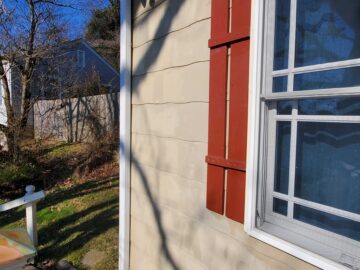
This image below shows a broken asbestos siding shingle, which has been sealed with latex paint. Shingles installed around window and door frames are more prone to cracking.
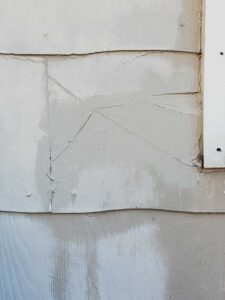
Is asbestos siding safe?
As long as asbestos siding remains intact, it poses no danger.
It’s not uncommon to see asbestos siding remain in perfect condition for 50–80 years or more.[4]
While asbestos-cement siding may eventually become cracked with age or impact, it is non-friable, meaning it isn’t easily crumbled or broken up by hand.[5] An exception is asbestos-containing stucco, which can more easily disintegrate into dust.
Danger arises when asbestos-cement siding is sanded, sawed, pulverized, or broken into small pieces, releasing asbestos particles into the air.
The inhalation of airborne asbestos fibers is associated with a number of severe health conditions, including:
- Asbestosis
- Lung cancer
- Mesothelioma
In general, the greater the exposure to asbestos, the greater the chance of negative health effects.
For homeowners, exposure is most likely to occur when asbestos products are disturbed through demolition, repair, maintenance, or remodeling.
So while home buyers may be tempted to remove all traces of asbestos from their property, if asbestos-containing siding is in good condition, the Environmental Protection Agency (EPA) recommends simply leaving it alone.
If, on the other hand, the original siding shows signs of wear like cracking and breakage, think about having it repaired, encapsulated, covered, or replaced.
How common is asbestos siding?
As many as half of homes in the U.S. contain asbestos, including hundreds of thousands that were built with asbestos-cement siding.[6] However, the use of asbestos in siding and other construction materials was largely eliminated by 1990, so that proportion is steadily declining as newer homes are added to the mix.
Why asbestos siding is no longer used in construction
In the 1960s, members of the medical community established a definitive link between job-related asbestos exposure and mesothelioma.[7]
In 1973, amid growing public concern, the EPA banned the spray-on application of asbestos-containing materials used for fireproofing and insulation.[8]
By 1989, the EPA had taken measures to ban 94% of asbestos used in the United States. While the district courts overturned that ruling in 1991, industry continued to opt for alternatives to asbestos siding, such as aluminum and vinyl.
Remaining stockpiles of asbestos-containing materials were used in construction throughout the 1980s, but homes built after 1990 are unlikely to contain asbestos.
| 🤔 Is asbestos siding banned in the U.S.?The manufacture, importation, processing, and distribution of some asbestos-containing products is still technically legal in the United States. However, it's heavily regulated by the EPA and the Occupational Safety and Health Administration (OSHA).In 2019, the EPA issued a ruling banning most uses of asbestos and ensuring that asbestos products that are no longer manufactured cannot return to the market without agency oversight.A complete list of banned uses of asbestos can be found on the EPA’s website. |
Even in asbestos’ heyday, not all manufacturers of cement shingles added the mineral to their product. Simply seeing cement siding on an older home doesn’t necessarily mean it contains asbestos.
How to tell if siding contains asbestos
While there’s a strong likelihood that original cement siding on an older home contains asbestos, the only way to know for sure is to have a sample professionally tested.
Not all siding companies added asbestos to their cement products. Just because it looks like asbestos siding doesn’t mean asbestos is actually mixed in.
Often, real estate agents familiar with the local housing inventory can advise home buyers on the likely presence of asbestos in siding and other materials.
Clever real estate expert Steve Nicastro advises that most homes built before the 1990s should be checked for a variety of environmental hazards like asbestos, lead paint, and mold.
"If you’re concerned," he says, "ask your property inspector to check specifically for that issue. If asbestos is suspected, they might recommend a specialist come out and do a more thorough inspection and offer guidance about remediation."
As a cheaper alternative to a professional inspection, asbestos testing kits can be found online for as little as $30. These allow you to remove a sample of the suspected asbestos-containing product and send it to a lab for analysis.
If you opt to DIY your asbestos testing, exercise extreme caution. While collecting the sample, you run the risk of releasing dangerous fibers into the air and either breathing them in or taking them into your home on your hair, skin, and clothing.
The EPA[9] strongly recommends letting a professional handle asbestos-containing products.
» READ: How Much Does It Cost to Test for Asbestos?
Does a seller have to disclose asbestos siding?
No federal laws require sellers to disclose the presence of asbestos to a buyer. But nearly every state has disclosure laws in place requiring sellers to give buyers specific information about the home’s structural features and condition, including known hazards like asbestos.
"In South Carolina," says Clever's Steve Nicastro, who has been buying and selling real estate in the area since 2018, "the seller has to disclose pretty much every major issue or defect that is known to them in what’s called a disclosure form. That includes environmental problems like mold or asbestos."
"If they have it and know they have it," Nicastro advises, "they have to disclose it."
What if the seller isn't aware of asbestos?
If a seller isn’t aware of asbestos, things get trickier. In that case, you might want to enlist the help of a local agent with knowledge of what to look for when dealing with homes built before 1990.
If you're at all worried about asbestos, your agent may recommend asking for a thorough asbestos inspection before you buy.
Most real estate contracts include an inspection contingency that allows buyers to look into the condition of a home before following through on the purchase. If asbestos or another red flag is discovered, you can either back out of the deal or try to negotiate with the seller to cover the cost of repairs.
Does asbestos siding need to be removed?
Not necessarily. Often, the safest course of action is to do nothing, especially if the siding is in good condition.
Asbestos only poses a risk when the fibers are released into the air and inhaled. Therefore, disturbing contained asbestos through removal may do more harm than good.
Potentially safer abatement options include encapsulating asbestos siding in a sealant or covering it with another siding material, such as vinyl or metal. When done by a professional, both are low-risk and effective ways to contain it.
If you’re determined to remove asbestos siding, the safest route by far is having an asbestos contractor handle it. A state-certified specialist will be familiar with local guidelines governing the removal and disposal of asbestos siding.
However, asbestos removal comes with a cost.
Repair options and costs
Cost to encapsulate asbestos siding
To encapsulate (or seal) asbestos siding, contractors charge an average of $2–6 per square foot.[10]
The process involves spraying the siding with a high-grade sealant to prevent asbestos fibers from becoming airborne.
Encapsulation may be both the safest and least expensive option, since it contains the asbestos without disturbing it — and also costs about half the price of removal.
When going this route, get quotes from multiple contractors and ask about the product that they’ll use. While there are many paints and primers on the market, you’ll want one designed specifically as a long-term encapsulant for asbestos.
While asbestos-cement can last several decades, it isn’t permanent. It tends to dry out and crack as it ages. Even encapsulated shingles will eventually need to be replaced.
Costs for replacement cement fiber shingles average $10 per square foot.
Cost to cover asbestos siding
Covering asbestos-cement with another siding material can cost $5–12 per square foot. The final price will depend largely on the type of siding you install.
The process of covering asbestos siding involves adding a vapor barrier and extra layer of insulation on top of the original siding and then placing new siding over it.
Popular asbestos siding replacement options include:
- Vinyl – $4 per square foot
- Fiber cement – $10 per square foot
- Natural wood – $3–10 per square foot
- Metal – $3–6 per square foot
While less affordable than encapsulation, covering asbestos siding is still more cost-effective and less hazardous than removal. It also provides a longer-term solution than encapsulation.
On the downside, there’s a risk of damaging the original cement shingles when nailing on the new insulation and siding. It can sometimes cause pieces to break off and bulge underneath.[11]
Before enlisting the help of a contractor, check local regulations to see if covering asbestos siding is allowed in your area. Some cities require full removal of asbestos-containing materials before applying new siding.
Finally, depending on the durability of the new siding material, you may need to replace it again after 15–20 years. If the original asbestos siding underneath is damaged, the cost (and risk) of removal could be even greater down the road.
Asbestos siding removal costs
Complete removal and replacement of asbestos siding can cost $13–20 per square foot, averaging $200 per hour.
The cost for removal alone is about $8–12 per square foot. To install new siding, contractors charge an average of $30 per hour, plus the cost of materials — typically $3–12 per square foot.
While pricier than encapsulating or covering asbestos siding with new material, full removal and replacement is the only option that offers a permanent solution.
A few states, such as New York and New Jersey, offer tax incentives to help homeowners recoup part of the cost of removal.[12]
In certain circumstances, like if you’re removing asbestos siding from a rental property you own, you may be able to write off a portion of the cost from your tax bill.[13]
Still, removing asbestos siding is no easy feat. Contractors must follow strict regulations set forth by the EPA, OSHA, and state and local governments. This includes the use of:
- Protective attire
- Respirator masks
- Shielding for the surrounding area
- Special containers for waste removal
Asbestos siding removal also requires a generous supply of water to keep the material damp (and thus less likely to release airborne fibers) during the removal process.
You can find a list of accredited asbestos removal companies by doing an online search for or contacting your state’s asbestos authority.
» MORE: Find trusted local asbestos contractors
Prior to the job, you may need to order a pre-removal inspection to confirm the presence of asbestos and the approximate amount that will need to be removed.
Some states require that you submit inspection findings, along with the removal project dates and facility where you will be disposing of the materials, with your removal notice application.
For peace of mind, you may also want to order a follow up inspection to ensure all traces of asbestos have been eliminated from your property. Some cities even require this.
| 🤔 Should you use the same company for inspection and removal?To avoid a potential conflict of interest, consider hiring a different company to do the asbestos pre-inspection before the start of any removal or repair work. Some homeowners are surprised to find that what they thought was asbestos siding contains no asbestos at all. |
Do homes with asbestos siding sell for less?
That depends. Some buyers may be scared off by the presence of asbestos anywhere in or around a home, says real estate investor Steve Nicastro. Others may expect a price reduction. Still others may not bat an eye — especially if the home is older and reasonably priced.
» READ: The Best (and Worst) Home Improvements for Resale
Siding is one of the lower-risk asbestos-containing materials, since the fibers are embedded in a solid medium (cement), which cannot be easily broken apart by hand.
Even so, asbestos siding can become increasingly brittle with age, making it more prone to cracking and breaking. It will eventually need to be dealt with through:
- Replacing damaged tiles with a non-asbestos cement alternative
- Covering the asbestos siding with another layer of siding such as vinyl or metal
- Encapsulating the siding in a special sealant
- Removing and replacing the siding altogether
If a seller is aware of asbestos siding, especially if the siding is in bad shape, they may adjust their asking price downward to account for the future cost of removal or repair.
If you decide to spring for a house with asbestos siding, you can set up an asbestos inspection to assess the potential hazard. Based on the inspector’s findings and recommendations for repair or removal, you may be able to negotiate a price reduction or repair concession with the seller (if they haven’t factored that into the listing price already).
| ❓Does a seller have to remove asbestos? While most states require sellers to disclose known asbestos, they aren’t legally obligated to fix it. You will need to address the issue during negotiations. |
While sellers may be hesitant to sink more money into a home they're leaving, it may be in their best interest to compromise. Other buyers are likely to have similar concerns about asbestos siding in need of repair.
If you’re concerned about how asbestos could affect your future home value, talk to an agent about their experience transacting deals with asbestos-containing homes.
In places where the housing inventory is older, and asbestos is a common issue, the presence of asbestos siding may not have as much bearing on resale value as you might think.
» Questions about buying a home with asbestos? Connect with a top-rated agent in your area!
Can you remove asbestos siding yourself?
Technically, yes. No federal law prevents homeowners from removing asbestos siding from a privately owned and occupied residence.
However, the EPA has strict regulatory guidelines governing the removal of asbestos.[9] State health departments have the authority to implement their own, often stricter standards as well.
State regulations might require you to:
- Order a pre-inspection of the work site by a certified asbestos inspector
- Submit a notice of intent to remove asbestos prior to beginning work
- Pay a fee based on the scope of the project
- Follow posted procedures for safe removal and disposal
- Wrap and seal asbestos-containing debris in approved containers
- Dispose of the waste at an approved landfill
State governments keep lists of asbestos landfill sites, which you should be able to find online or through contacting your state’s asbestos authority. You cannot dispose of asbestos in your regular garbage container.
Contact your state health department for more information about state asbestos laws and guidelines.
Even for minor jobs involving asbestos, the EPA and Consumer Product Safety Commission strongly recommend hiring a professional trained in the safe handling of asbestos materials.[1]
Asbestos contractors know the rules and have both the training and equipment to do the work safely.
If you’re determined to do your own asbestos siding removal, you’ll need to adhere to state and local guidelines, including submitting any required notices, fees, and waste disposal records.
| ⚠ CAUTION: Be mindful of the dangers of inhaling asbestos fibers during or after DIY removal and strongly consider hiring an asbestos-certified contractor to do the job. Professional help may be costly, but it’s well worth avoiding a potentially serious risk to your health. |
Bottom line: Should you buy a home with asbestos siding?
Buying a home with asbestos siding can be an intimidating proposition. But it doesn’t have to be a deal breaker. The important thing is that you're aware of the potential issues and 100% comfortable with your decision.
If you’re shopping for older homes that may have built with asbestos siding, your best bet is to know your options as a buyer:
- Ask your real estate agent about potential environmental hazards like asbestos while looking at homes.
- Write an inspection contingency into your offer and order an inspection to detect asbestos siding and determine whether it needs to be repaired.
- Use the discovery of asbestos siding to negotiate a better asking price or repair concession with the seller.
- Ask the seller to take care of removal or remediation before the property changes hands.
- Buy the home as is, and simply leave the siding intact (if it's in good condition) or repair or replace it yourself.
- Walk away from the purchase and find a property that you’d be more comfortable calling home.
From pointing out the potential presence of asbestos in a home, to offering recommendations for how best to address it with a seller, an experienced, local agent can be a great resource.
» NEED A SAVVY AGENT? Connect with a top-rated agent in your area!
Asbestos siding FAQs
Is it safe to live in a house that has asbestos siding?
Yes, as long as the material isn’t disturbed, and the asbestos fibers stay contained within the cement, asbestos siding is safe. Asbestos siding can remain in perfect condition for 50–80 years or more.
With older siding, a fresh coat of paint or new siding placed over the original cement shingles is a good way to keep the material contained.
How much does asbestos siding removal cost?
On average, asbestos removal costs $6–8 per square foot, or $200 per hour.
To replace the removed siding, you’re looking at an average of $30 an hour, plus the cost of materials, which range from about $3–10 per square foot for a typical grade vinyl, aluminum, cement, or wood shingle.
Is asbestos siding removal covered by insurance?
Most of the time it's not. However, asbestos siding removal may be covered if the siding is damaged by a factor outside of your control, such as a hurricane or other natural disaster.
Can you put vinyl siding over asbestos siding?
Yes! Covering asbestos with another cladding material may actually be a safer route than removal. It will typically cost $7,500–18,000 depending on the scope and size of the project.
Does asbestos siding affect resale value?
Possibly, but asbestos siding poses a lower risk than other types of asbestos material and also does a good job of insulating the home, so some buyers may not see it as a negative.
Others, however, won’t want to buy the home due to the perceived risk or may ask for a price reduction.
How long does asbestos siding last?
Due to its highly durable nature, asbestos siding can remain perfectly intact for 50 years or more. Encapsulating asbestos siding in fresh paint can make it last even longer.

